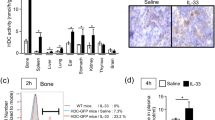Abstract
Jaundiced patients experience intense pruritus, the pathophysiology of which is unclear. In this study, blood histamine concentrations, skin mast cell counts and intracellular histamine concentrations in peritoneal mast cells were examined in an experimental model of biliary obstruction. Three weeks after bile duct ligation (BDL), total blood histamine concentrations were significantly elevated compared with those from control animals (p<0.0001). Skin mast cell counts were increased (p<0.05) and peritoneal mast cell histamine content decreased (p<0.05) in jaundiced animals. These results demonstrate that mast cells degranulate in biliary obstruction with consequent release of histamine into the systemic circulation. This may contribute to cholestatic pruritus. These data may have significant pharmacological implications in patients with obstructive jaundice.
Similar content being viewed by others
References
R. H. Wiesner, N. F. LaRusso, J. Ludwig and E. R. Dickson,Comparison of the clinicopathologic features of primary sclerosing cholangitis and primary biliary cirrhosis. Gastroenterol.88, 108–114 (1985).
J. M. Garden, D. J. Ostrow and H. H. Roenigk,Pruritus in hepatic cholestasis. Arch. Dermatol.121, 1415–1420 (1985).
M. Ennis,Automated fluorometric assays. Handbook Exp. Pharmacol.97, 31–38 (1991).
J. R. Gordon, P. R. Burd and S. J. Galli,Mast cells as a source of multifunctional cytokines. Immunol. Today11, 458–464 (1990).
F. Schaffner,Cholestyramine, a boon to some who itch. Gasterenterol.46, 67–69 (1964).
R. G. Quist, H.-T. Ton-Nu, J. Lillienau, A. F. Hofmann and K. E. Barrett,Activation of mast cells by bile acids. Gastroenterol.101, 446–456 (1991).
K. H. Peh, B. Y. C. Wan and E. S. K. Assem,Characteristics of deoxycholic acid-induced histamine release from mast cells of guinea-pig rectocolonic mucosa and rat peritoneal cavity. Agents and Actions33, 76–80 (1991).
S. Norn, P. Clementsen, K. S. Kristensen, C. Hannoun and J. O. Jarlov,Carbohydrates inhibit the potentiating effect of bacteria, endotoxin and viruses on basophil histamine release. Agents and Actions30, 53–56 (1990).
Author information
Authors and Affiliations
Rights and permissions
About this article
Cite this article
Clements, W.D.B., O'Rourke, D.M., Rowlands, B.J. et al. The role of mast cell activation in cholestatic pruritus. Agents and Actions 41 (Suppl 1), C30–C31 (1994). https://doi.org/10.1007/BF02007753
Issue Date:
DOI: https://doi.org/10.1007/BF02007753




